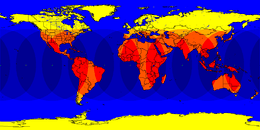O3b (satellite)
 Rendering of O3b satellite coverage areas and visibility around the equator. | |
| Operator | O3b Networks |
|---|---|
| Spacecraft properties | |
| Dry mass | 700 kg |
| Start of mission | |
| Launch date |
June 25, 2013 (four) July 10, 2014 (four) December 18, 2014 (four) March 9, 2018 (four) |
| Orbital parameters | |
| Reference system | Geocentric |
| Regime | Medium Earth |
| Eccentricity | Circular |
| Perigee | 8063 km |
| Repeat interval | 5 daily |
| Velocity | 11,755 mph |
O3b is a satellite constellation designed for telecommunications and data backhaul from remote locations.
The first four satellites were launched on 25 June 2013,[1], eight more in 2014 (four satellites on 10 July 2014 and four on 18 December 2014), and four more on 9 March 2018[2]. The constellation will be extended to twenty satellites in 2019.[3]
The constellation is owned and operated by O3b Networks, which is a wholly owned subsidiary of SES S.A. The O3b constellation began offering service in March 2014.[4]
Satellites
The first satellites were deployed in a circular orbit along the equator at an altitude of 8063 km (medium Earth orbit) at a velocity of approximately 11,755 mph (18,918 km/h), each making 5 orbits a day.[5] As of 2018, the constellation has sixteen satellites operational in orbit, after four launches of four satellites each. Due to problems with a component of the first four satellites launched, three of those four have been placed on standby for the other three, so thirteen are used operationally.[6]
Each satellite is equipped with twelve fully steerable Ka band antennas (two beams for gateways, ten beams for remotes) that use 4.3 GHz of spectrum (2×216 MHz per beam) with a proposed throughput of 1.6 Gbit/s per beam (800 MBit/s per direction),[7] resulting in a total capacity of 16 GBit/s per satellite. Each beam's footprint measures 700 km in diameter.[8] O3b claims a mouth-to-ear one-way latency of 179 milliseconds for voice communication, and an end-to-end round-trip latency of 140 ms for data services. The maximum throughput per TCP connection is 2.1 Mbit/s.[9] For maritime applications, O3b claims a round-trip latency of 140 ms, and connectivity speeds of over 500 Mbit/s.[10]
The satellites are powered by gallium arsenide solar arrays and lithium ion batteries[11] and weigh approximately 700 kilograms (1,500 lb) each.[1]
The satellites were constructed by Thales Alenia Space, a division of Thales Group.[12] The first satellite (PFM) was built in the Cannes Mandelieu Space Center, while the rest of the constellation was assembled, integrated and tested in Thales Alenia Space Italy's Roman facilities.
In September 2017, SES announced the next generation of O3b satellites and placed an order for an initial seven from Boeing Satellite Systems using a new satellite platform based on Boeing’s 702 line of scalable buses. Expected to launch in 2021, the O3b mPower constellation of MEO satellites for broadband internet services will "be able to deliver anywhere from hundreds of megabits to 10 gigabits to any ship at sea" through 30,000 spot beams. Software-defined routing will direct traffic between the mPower MEO satellites and SES' geostationary fleet.[13]
References
- 1 2 "Soyuz Flight VS05 with four O3b networks satellites". Arianespace. 25 June 2013. Retrieved 6 October 2017.
- ↑ "Successful Launch of Four O3b Satellites Expands Fibre-like Connectivity". SES S.A. 9 March 2018. Retrieved 11 March 2018.
- ↑ "SES takes control of O3b, citing synergies between GEO, MEO constellations". 2016.
- ↑ Wood, Lloyd; Lou, Yuxuan; Olusola, Opeoluwa (2014). "Revisiting elliptical satellite orbits to enhance the O3b constellation". Journal of the British Interplanetary Society. 67 (3): 110–118. arXiv:1407.2521. Bibcode:2014JBIS...67..110W.
- ↑ "iDirect's Interoperability with O3b's MEO Satellite System". 2008.
- ↑ "Two O3b Satellites Taken Out of Service as a Precaution". 2014.
- ↑ "O3b Networks Presentation" (PDF). presentation. O3b Networks. 23 February 2009. Retrieved 9 January 2013.
- ↑ "O3b website – Our technology". website. O3b Networks. Retrieved 9 January 2013.
- ↑ "Why Latency Matters to Mobile Backhaul" (PDF). O3b Networks and Sofrecom. 18 April 2013. Archived from the original (PDF) on 18 November 2013.
- ↑ "O3b Maritime" (PDF). O3b Networks. 18 June 2012. Archived from the original (PDF) on 24 October 2012.
- ↑ "O3b Networks : Space Vehicle". Archived from the original on 19 February 2009.
- ↑ "O3b Networks : Advantage". Archived from the original on 3 March 2011.
- ↑ SES building a 10-terabit O3b ‘mPower’ constellation Space News September 11, 2017. Accessed October 31, 2017